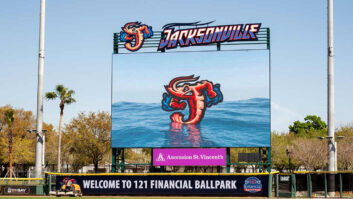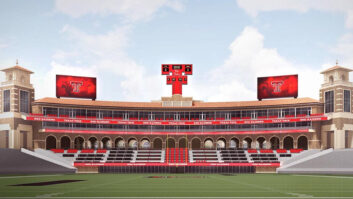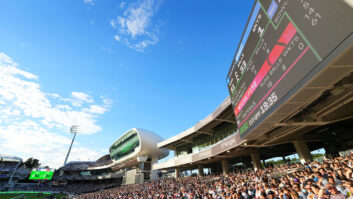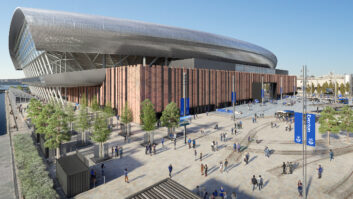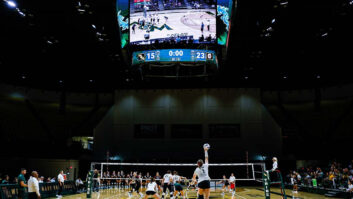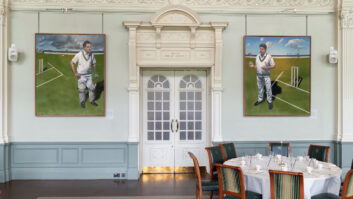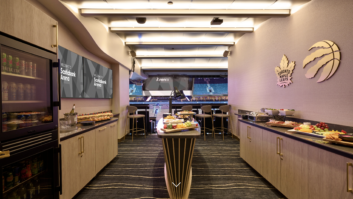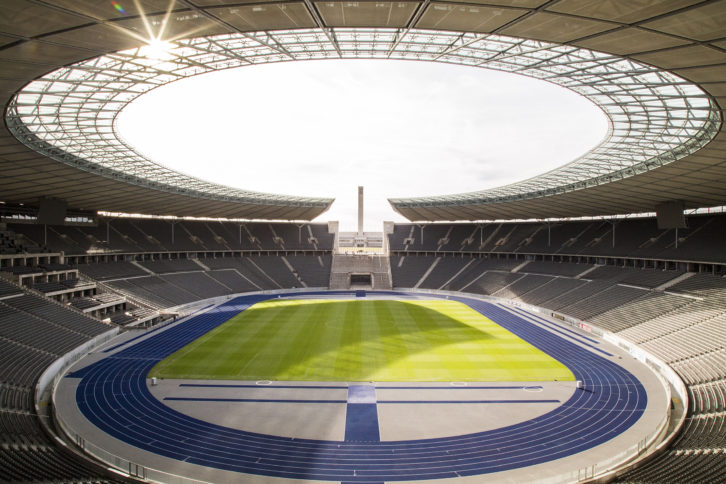
Previously we considered the main drivers behind the growing use of technology in stadiums, here Ian McMurray looks at the ways to maximise ROI from display technology deployments.
Widespread deployment of screens can generate a variety of revenue streams.
“From a technology point of view, LED displays are transforming stadiums into world class multi-purpose venues, which enables them to look beyond sport into venue hire for private events, music gigs, corporate events and even large scale Esports events – a growing area of opportunity,” believes Mark Childerhouse, director, Pioneer Group.
And: he thinks things could get personal – perhaps the ultimate form of engagement.
“There is substantial investment in the upgrade of Wi-Fi networks and Wi-Fi integration into displays for rapid deployment of content and live social feeds,” he adds. “A fully connected stadium means that the attendee can have multiple tailored touch points as soon as their ticket is scanned.”
As is increasingly the case with almost any AV deployment, the installation isn’t looked on as an expense – but an investment. However, as Daniel Gray, marketing officer at ADI, points out, just hanging a number of screens and waiting for the money to come rolling in is a poor strategy.
“We consult with many clubs and sports venues to help them maximise ROI from their display technology,” he says. “The best results are achieved when clubs think about display technology as a holistic platform, rather than each in isolation. By considering display technology as a stadium-wide brand activation platform, clubs are able to define partner programmes that deliver a much greater yield than simply thinking about each platform as separate advertising channels.”
“For example,” he continues, “we’ve seen clubs outside of top tier football increase revenue by 1,700% by rethinking the way they commercialise digital platforms. Those clubs who think differently achieve a far greater return than some of those clubs in higher divisions who still apply the old media models that have been around for 20 years.”
Significant contribution
There is also sponsorship. In the UK, clubs like Manchester City (Etihad), Arsenal (Emirates), Leicester City (King Power) and Brighton (AmEx) have all renamed their grounds as part of sponsorship deals. Shirt sponsorship in the Premier League is worth in excess of £300 million each season (Chevrolet, for example, pay Manchester United almost £50 million) – and there’s almost £50 million on top of that for sleeve sponsorship… Those sponsors need to be kept happy, and in-venue brand exposure on-screen can make a significant contribution.
What makes them particularly happy, though, is not just for the brand to be exposed to 50,000 fans in the stadium: exposure on TV is, in effect, the holy grail with its audience measured in tens of millions. Here too, there are interesting developments.
“The best results are achieved when clubs think about display technology as a holistic platform, rather than each in isolation”
Daniel Gray, ADI
“With perimeter LED technology, there is increasing demand for virtual hybrid functionality,” says Gray. “This technology makes it possible to virtually change the perimeter content seen by fans watching a game in different countries, meaning brands can pick and choose the markets they target, or change their message for different territories. For clubs and brands, it’s game changing – allowing them to unlock new revenues from a media platform that had previously reached its peak in tier one sports.”
Ben Kershaw, managing director of Pro Display, helps calibrate the impact of that. “We’ve been told by a client that a minute of Premiership pitch-side advertising can cost companies in the region of £30,000,” he says.
Advertising does, of course, have a key role to play in revenue generation – but it’s not the be-all and end-all.
ROI calculation
“Some clubs may not have the attendance to drive major advertising revenue,” states Ewan Prentice, business development manager at Daktronics. “For those teams, the ROI calculation may be driven by season ticket sales or an increase in event attendance. For most facilities, the ROI calculation will likely be a combination of the two factors.”
Lack of funding to make the investment, however, need not be a barrier. There is, potentially, another approach as Andy Truswell, Pure AV systems integration manager, points out.
“One way that sports stadia are overcoming this barrier is through arrangements with media companies,” he explains. “In this scenario, the media company covers the cost of the hardware and installation, recovering their investment through ongoing advertising revenues, which are also shared with the stadium.”
While screens are the most visible element of technology deployment in stadia, there are other opportunities.
“Technology also has a part to play during the live event,” says Truswell. “‘Dual screening’ is now a part of modern life, and the desire and capacity of fans to consume content alongside the live action shouldn’t be underestimated. The need for stadiums to respond and to provide opportunities for fans to engage with good quality content replays and statistics is driving an increase in demand for solutions that enable interaction between mobile devices and the AV on site.”
“App integration is a crucial element of the activity, especially for mid-tier LED displays,” adds Childerhouse. “Fan engagement is encouraged by fans that can’t make the game with the integration of social media and the highlighting of content from players to increase their profile within the stadium environment.”
Boost engagement
“App development is a major part of our work,” he continues, “to boost engagement and create a more integrated fan experience. Technologies such as VR/AR are very exciting and we’re certainly exploring possible avenues. VR in particular, opens up the possibility for fans to have a stadium experience from home, even from the other side of the world.”
“Given the need for stadia to continually seek new ways to increase fan engagement,” Truswell adds, “perhaps the most exciting developments in screens and displays will be around how we connect and share content between them and other devices, particularly mobiles and wearables.”
“App development and VR/AR isn’t something we see much of in relation to sports stadiums just yet,” says Kershaw. “However, these are aspects that we expect to take off in coming years. We find our products – such as our projection simulation screens and our interactive mirror screens – complement or facilitate VR and AR. As time goes on, we do expect to see more stadiums taking on these ventures but we find as yet – ‘next gen’ stadiums aside – the wider focus is still very much on passive displays in this industry rather than interactive.”
Inevitably, much of the discussion of the deployment of leading edge technology in stadia will revolve around the sports with the most money – and that, of course, means football. The same principles apply, however, whatever the sport: whether it’s boxing, athletics, rugby, cricket or hockey – anywhere a crowd is likely to gather to watch a match or game – the same principles apply. As with any other AV industry segment: for those prepared to invest in understanding the business, sport represents an excellent prospect as its use of technology to drive revenue increases.
For manufacturers and integrators alike, it is truly a marketunity.
www.adi.tv
www.daktronics.com
www.pioneergroup.co.uk
www.prodisplay.com
www.pureav.co.uk
